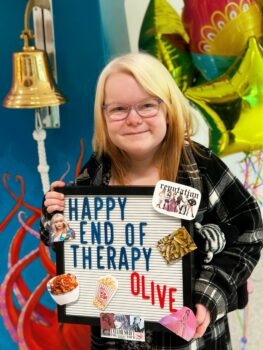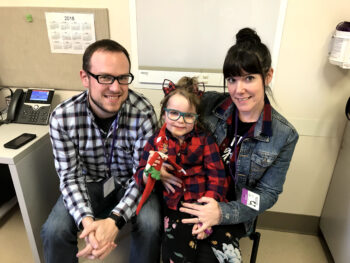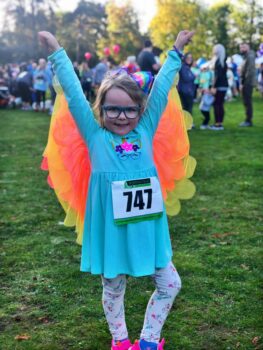 Kind and sassy Olive Ray is a typical fifth grader, with a deep love for Taylor Swift, horses, chocolate ice cream, and her little sister, January. But the 10-year-old also has some special skills, like having fun even while getting chemotherapy, raising thousands of dollars for brain tumor research and explaining how clinical trials work to her classmates.
Kind and sassy Olive Ray is a typical fifth grader, with a deep love for Taylor Swift, horses, chocolate ice cream, and her little sister, January. But the 10-year-old also has some special skills, like having fun even while getting chemotherapy, raising thousands of dollars for brain tumor research and explaining how clinical trials work to her classmates.
Olive’s parents, Trista and Aaron, noticed her eyes were doing “weird, funky stuff” when she was 22 months old. An MRI at Seattle Children’s revealed an optic nerve glioma, a non-cancerous brain tumor sitting in Olive’s optic chiasm, where the left and right optic nerves cross. It’s the most common brain tumor diagnosed in children. To conserve her sight, Olive’s tumor is considered inoperable.
The day the Rays were introduced to Olive’s glioma, they also met Dr. Sarah Leary, medical director of Seattle Children’s Brain Tumor Program and a researcher in Seattle Children’s Research Institute’s Ben Towne Center for Childhood Cancer Research, and Cory Hoeppner, a neuro-oncology nurse practitioner who has worked at Children’s for 25 years. Under their care, Olive underwent a year of chemotherapy.
“It’s the same chemo they’ve been giving these tumors for over 60 years, and it’s still the number one line of treatment,” Trista said. “By the time she turned 3, the tumor had shrunk as much as it could. She had great success.
“I didn’t know it at the time, but Cory said she knew we’d be back. She’s seen so many of these tumors and she knew it would regrow,” said Trista. Indeed, though it remained stable for a couple of years, the tumor started growing again.
Searching for answers

This time around, there weren’t easy answers. Then and now, there are no standard therapies for patients whose optic nerve gliomas progress after initial therapy. This reveals a critical, unmet need: new medicines developed for pediatric brain tumors.
The absence of proven next steps meant a hit-or-miss approach, and for Olive, it was a lot of misses, despite her family’s hopes and her medical team’s best efforts. Four different single or combination therapies were started and stopped early, as they were ineffective against her tumor.
“Olive’s tumor isn’t massive but where it’s located is pretty tricky,” Aaron said. “It’s got a nice little home if it stays small, but if it grows, it has a lot of important stuff it can mess around with.”
By the time Olive was 8, the space in her brain taken by the marshmallow-sized tumor made fluid collect, causing headaches and nausea. Her vision, ability to concentrate and trademark cheerfulness deteriorated. It was difficult for her to complete a school day. With the glioma pressing against her pituitary gland, she stopped growing and gained weight.
“She was starting to suffer, and we were in a tight spot without any medications they knew could even be helpful,” Trista recalls. Radiation was a possibility the Rays hoped to avoid, given its effects on growing brains. But she remembers Cory commenting, “She’s just not herself. I can tell we need to do something because her whole demeanor is different.”
“If I wasn’t asleep, I had a headache, and if I didn’t have a headache, I was hangry,” Olive said.
“She wasn’t enjoying life,” agreed Trista. “She’s got a lot of friends, and she wasn’t hanging out with them too much. She just didn’t have the energy or desire to do things.”
In September 2021, Olive had surgery to place a shunt in her head to drain the accumulated brain fluid. At the same time, Children’s surgeons snipped a bit of her tumor to better understand its characteristics.
Soon after, Dr. Leary hurriedly called the Rays to let them know Olive’s tumor biopsy revealed markers that qualified her for a new clinical trial just beginning at Children’s and 12 other U.S. sites.
“We were desperate, and it was clear Dr. Leary was very, very excited about this trial and she really wanted Olive to be in it,” Trista said. “She was absolutely ecstatic when she got official word that Olive could be a part of the trial. She said, ‘You guys — this is amazing news!’ We couldn’t help but be hopeful.”
The clinical trial is testing whether a protein kinase inhibitor medicine can halt gliomas like Olive’s by slowing down the cellular pathway driving the growth of tumor cells. It’s a next-generation, more precise therapy with lighter side effects, targeted to Olive’s specific genetic need.
Innovative trials like this test whether a new medicine, device or treatment is safe and effective, part of Children’s ongoing research efforts to ensure its young patients benefit from advances more quickly. Seattle Children’s physician-researchers help lead and are a part of various consortiums of like-minded pediatric hospitals around the world impatient for better therapies, offering access to trials and treatments not found elsewhere. Breakthrough clinical trials help Children’s doctors discover the most effective, least invasive and best options for the kids who need it most.
It was quickly clear the trial medicine was making an impact. “Three months after starting the medication, it was really apparent to us that something good was happening because it was obvious Olive was feeling better,” said Trista. “We all felt really confident we were going to see good news on her scan.” They did, and over her two years on the trial, the tumor shriveled to the size of a raisin. It made Olive’s skin sensitive and lightened her hair, but her quality of life soared.
“I am in online groups for parents whose kids have the same tumor as Olive and this particular study is all the buzz. People are scrambling to be a part of it,” Trista said. “I’m definitely excited to share how well she’s done and how excited our doctors are.”
Moving research forward
“We are so lucky; that is not lost on us,” Trista said. “Ever since Olive’s diagnosis, we have given a ton of our time and effort to help raise money for Seattle Children’s Research Institute. We’ve been very involved in Run of Hope Seattle, raising funds for the Brain Tumor Pediatric Research Fund to support Seattle Children’s efforts. There once were no trials here in Seattle that related to Olive’s condition. But Dr. Leary’s partnership with networks of researchers gave us an in to get into this trial. I feel like we won the lottery.”

Aaron agrees: “We really can draw a line from the fundraising that we’ve done with Run of Hope —around $130,000 with Team Oli over the past eight years — to making more trials accessible at Seattle Children’s, like the one she’s in and others. It’s good to feel like we’re doing not nothing.”
When Olive finished two years on the trial medicine in January 2024, she rang the “done with treatment” bell at Children’s and savored her good health. She is now off treatment for the first time in five years. The Rays are cautiously optimistic and excited to enjoy family life unencumbered by clinic visits and medications.
Aaron is introspective about what the experience of having a child with a chronic condition has taught him. “It revealed the resilience of everyone in our family,” he said. “But the biggest takeaway is there is so much opportunity for us to help move research forward, to help take care of the families that are in this spot. And there’s just so much to do. That can be very overwhelming, but at the same time, I didn’t even know that it existed prior to this. So, I’m very thankful for being exposed to this community — all the needs it has, all that people are doing to help. It’s really inspiring.”
Resources:
Support Seattle Children’s Ben Towne Center for Childhood Cancer Research

